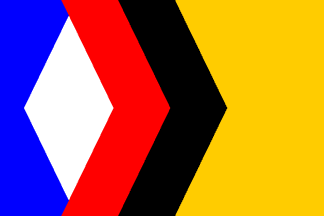
Last modified: 2016-03-14 by zoltán horváth
Keywords: e | Э | coat of arms (bull) | chevron (black) | chevron (red) | engels | Êngelhs | Энгельс |
Links: FOTW homepage |
search |
disclaimer and copyright |
write us |
mirrors

The city was founded in 1747 as Pokrovsk, renamed Engyel’s
in 1932 in honour of Friedrich Engels and was the capital of the
Volga German ASSR.
Jarig Bakker, 23 Feb 2002
Pokrovsk (since 1931 — Engels-city) has been founded in 1747 on a way of delivery of salt from Elton Salt Lake. Salt carried on bulls. Till 1941 Engels-sity (Stadt der Friedrich Engels) was capital of ASSR of Volga’s Germans. In structure of the Municipal Rayon of Engels-sity are municipalities (= counties):
At 10.30 of hours of August 8, 2002 24 extraordinary session of
municipal Assembly of the deputies of Engels-city municipality (Region
of Saratov, Russia) by the decision Nº 390/24-02 has ratified
a flag of Engels-city municipality. The author of the project of a
flag is czech vexillologist Petr Exner
(Hradec Kralove, CZ).
Mikhail Revnivtsev, 09 Aug 2002
This flag is vexillographical transformation (reconsideration) of the
coat of arms of this municipality.
Mikhail Revnivtsev, 24 Oct 2005
The decision about a flag says:
3.1. The flag of Engels-city municipality represents a rectangular panel consisting of a blue field at staff and a yellow field at fly border of a flag, which are blocked by two shevrons — red and black, which tops are inverted to middle of fly border of a flag. The top red shevron coincides with the centre of a panel of a flag, the top black shevron will defend on 2/3 lengths of a flag from staff. On a blue field is represented to red shevron a white vertical rhombus of height in 3/4 width of a flag. The attitude of width of a flag to his length is 2:3.
3.2. The flag is developed on the basis of the coat of arms of Engels-city municipality. Classical heraldic figure shevron was chosen on to similarity to horns of the bull and bowll, the white rhombus reminds silver of salt in bowll on the coat of arms. Directed to fly border of a flag of an edge shevrones symbolize dynamical development of Engels-city municipality). Red and black shevrones has form the letter "Э" - first letter of the name "Engels" in Russian, a dark blue and white field form the letter "E" - first letter of the name of city in Latin.
Yellow colour (gold in heraldry) - symbol of riches, durability, greatness, intelligence, magnanimity. On a flag the yellow colour symbolizes gold fields Transvolgian area, riches of soul of his inhabitants. This colour has a shield in the coat of arms of Engels-city municipality.
Red colour - symbol of courage, selflessness, fair struggle and life. In the coat of arms are represented red bowll, the bull has red eyes, horns, language and foots.
White colour - symbol of cleanliness, nobleness, world, ????????????????????. In the coat of arms this colour have salt in bowll on a back of the bull and three fishes in the coat of arms of the Region of Saratov. Black colour - symbol of wisdom, patience, restraint, colour of fertile ground Transvolga area, colour raped by the sun of ground ancient " Great Salt ways " from Elton lake. Black the bull in the coat of arms is represented. The blue colour on a flag symbolizes the great river of Russia - Volga. Blue colour there is a free part in the coat of arms with the image three silver fishes The combination of white, dark blue and red colours repeats colours of a State flag of Russian Federation. symbolizes an accessory of Engels-city municipality to Russian Federation. The combination of white and blue colours symbolizes colours of the coat of arms of the Region of Saratov (three silver fishes in blue shield), and the white and red colours repeat colours of a flag of the Region of Saratov area and testify that the municipality is a part of the Region of Saratov. The combination of yellow and blue, black, red and yellow colours reflects features of settling and historical development of Engels-city municipality.
Mikhail Revnivtsev, 09 Aug 2002
en.gif)
The coat of arms has been adopted on July, 6, 2001 and readopted
on June, 14, 2001. Authors of the coat of arms are Vladimir Nikitin
and Mikhail Revnivtsev.
Mikhail Revnivtsev, 24 Oct 2005
Anything below this line was not added by the editor of this page.